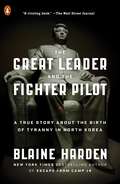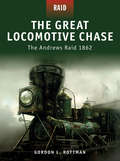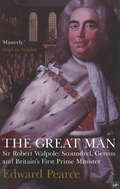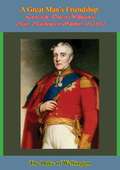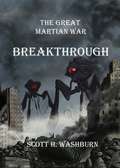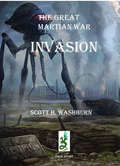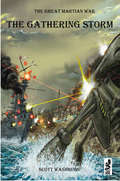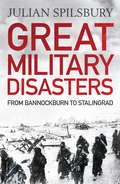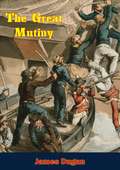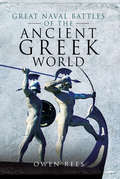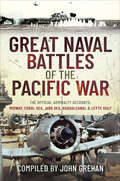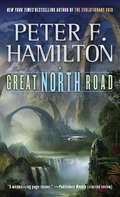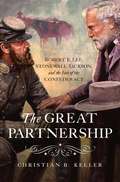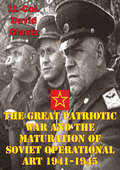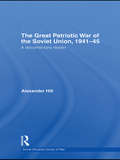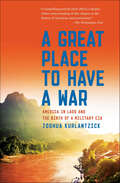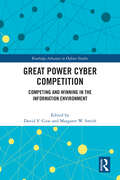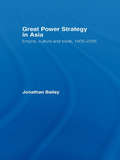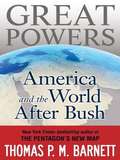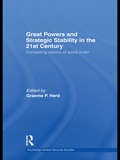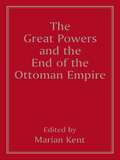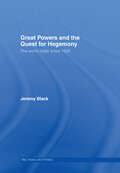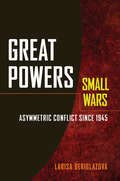- Table View
- List View
The Great Leader and the Fighter Pilot
by Blaine HardenFrom the New York Times bestselling author of Escape From Camp 14, Blaine Harden tells the riveting story of Kim Il Sung's rise to power, and the brave North Korean fighter pilot who escaped the prison state and delivered the first MiG-15 into American handsIn The Great Leader and the Fighter Pilot, New York Times bestselling author Blaine Harden tells the riveting story of how Kim Il Sung grabbed power and plunged his country into war against the United States while the youngest fighter pilot in his air force was playing a high-risk game of deception--and escape.As Kim ascended from Soviet puppet to godlike ruler, No Kum Sok noisily pretended to love his Great Leader. That is, until he swiped a Soviet MiG-15 and delivered it to the Americans, not knowing they were offering a $100,000 bounty for the warplane (the equivalent of nearly one milliondollars today). The theft--just weeks after the Korean War ended in July 1953--electrified the world and incited Kim's bloody vengeance.During the Korean War the United States brutally carpet bombed the North, killing hundreds of thousands of civilians and giving the Kim dynasty, as Harden reveals, the fact-based narrative it would use to this day to sell paranoia and hatred of Americans.Drawing on documents from Chinese and Russian archives about the role of Mao and Stalin in Kim's shadowy rise, as well as from neverbefore- released U.S. intelligence and interrogation files, Harden gives us a heart-pounding escape adventure and an entirely new way to understand the world's longest-lasting totalitarian state.From the Hardcover edition.
The Great Leader and the Fighter Pilot: The True Story of the Tyrant Who Created North Korea and the Young Lieutenant Who Stole His Way to Freedom
by Blaine HardenFrom the New York Times bestselling author of Escape From Camp 14, Blaine Harden tells the riveting story of Kim Il Sung's rise to power, and the brave North Korean fighter pilot who escaped the prison state and delivered the first MiG-15 into American handsIn The Great Leader and the Fighter Pilot, New York Times bestselling author Blaine Harden tells the riveting story of how Kim Il Sung grabbed power and plunged his country into war against the United States while the youngest fighter pilot in his air force was playing a high-risk game of deception--and escape.As Kim ascended from Soviet puppet to godlike ruler, No Kum Sok noisily pretended to love his Great Leader. That is, until he swiped a Soviet MiG-15 and delivered it to the Americans, not knowing they were offering a $100,000 bounty for the warplane (the equivalent of nearly one million dollars today). The theft--just weeks after the Korean War ended in July 1953--electrified the world and incited Kim's bloody vengeance.During the Korean War the United States brutally carpet bombed the North, killing hundreds of thousands of civilians and giving the Kim dynasty, as Harden reveals, the fact-based narrative it would use to this day to sell paranoia and hatred of Americans.Drawing on documents from Chinese and Russian archives about the role of Mao and Stalin in Kim's shadowy rise, as well as from never-before-released U.S. intelligence and interrogation files, Harden gives us a heart-pounding escape adventure and an entirely new way to understand the world's longest-lasting totalitarian state.From the Hardcover edition.
The Great Locomotive Chase - The Andrews Raid 1862
by Gordon Rottman Mariusz KozikIn April 1862, the stage was set for one of the greatest locomotive chases in history. Union forces planned to steal a train and travel at high speed to Chattanooga, Tennessee, disabling the line as they went, in order to cut off vital rail supplies to the Confederate stronghold of Atlanta, Georgia, some 100-plus miles to the southwest. What they hadn't banked on was the dogged determination of one man, train conductor William Fuller, who, after realizing his train had been stolen, began a frantic pursuit, first by handcar, then by top-speed locomotive, dealing with derailments by running miles on foot to the next station, and single-handedly removing drag ties from the track in front of his train. The raiders were so hotly pursued that they had no time to inflict serious damage on the tracks and could not stop to gather more fuel. Just north of Ringgold, some miles south of Chattanooga, The General ran out of wood and the raiders scattered into the forested Appalachian Mountains. All were captured within days and sentenced to death. Discover the history of one of the most colorful and dramatic episodes of the Civil War as Gordon L. Rottman expertly recounts this incredible tale of sabotage, robbery and raiding on the rail lines of the Deep South.
The Great Man: Sir Robert Walpole: Scoundrel, Genius and Britain's First Prime Minister
by Edward PearceThe year 1721 has many splendours: great houses built by William Kent, fine pictures and the fruits of commerce. But there are also thirteen public hanging days a year, drunkenness is endemic, organised crime rampages through the streets. And politics are ferocious. Only a generation earlier, The Pretender failed to take the Crown; the new King is cursed as a damned foreigner; James's followers - the Jacobites - conspire and are persecuted; the South Sea Bubble collapses.Robert Walpole, once imprisoned for financial chicanery, assumes political control and becomes 'Prime Minister'. He personally detects a Jacobite plot, is dismissed in 1727 on the death of George I, recruits the new King's clever wife, Caroline, and bounces cheerfully back. Coarse, corrupt and cynical, Walpole dominates King, Parliament and Government until 1742. This is Mr Worldywiseman, keeping England out of war for twenty years and setting up a stable and growing economy. All politics of a kind we can recognise today begin with Robert Walpole. And here, in Edward Pearce's elegant book, he is brought vividly back to life.
A Great Man’s Friendship: Letters of the Duke of Wellington to Mary, Marchioness of Salisbury, 1850-1852
by Lady Burghclere The Duke of WellingtonOriginally published in 1927 and edited by Lady Winifred Anne Henrietta Christiana (Herbert) Burghclere, this book is a collection of the Duke of Wellington's letters to one of his regular correspondents and friend, Mary Catherine Gascoyne-Cecil, Marchioness of Salisbury. The letters in this volume cover the years 1850-1852--the last two years of the Duke of Wellington's life. It ends with the Duke's final note dated September 13, 1952, the eve of his death."The Duke's actions were sometimes mistaken, his judgments sometimes faulty, but the advocatus diaboli can find nothing to challenge in the limpid sincerity of his selfless motives. In these letters, too, the man's kindliness, the "good nature" he proclaimed as so important an ingredient, even in public affairs, is markedly apparent."It is also an illustration of the force of willpower to see an octogenarian able to put through the business which every day brought him. He might grumble that "every animal but the Duke of Wellington is allowed a rest," but the myriad tasks, the countless courtesies and kindnesses, were achieved largely by his lifelong system "to do the business of the day in the day."It is therefore to be hoped that the perusal of these letters will give their readers a more intimate acquaintance with one whose whole career and character must be a source of pride to those of his own race."Illustrated with Portraits.
The Great Martian War: Breakthrough
by Scott WashburnThe Battle for Earth continues! The merciless invaders from the Red Planet have entrenched themselves all over the world, but President Theodore Roosevelt and the men of the US Army and Navy are focused on the aliens threatening the American heartland. As forces are rushed to meet the invader, science and industry race to build the weapons needed to match the fantastic machines of the aliens. But not all is well with the Martians as they struggle to adapt to a new world. The lines are drawn as each side prepares for what they hope will be the decisive battle. This is the second book in the first trilogy of The Great Martian War.
The Great Martian War: Invasion! (The\great Martian War Ser. #1)
by Scott WashburnFollowing the defeat of the Martian invasion of Britain, a new threat to humanity lands in the American west. President Roosevelt musters the captains of industry and leading scientists to find a way to turn back the Martian tide
The Great Martian War: The Gathering Storm (The Great Martian War #5)
by Scott WashburnAfter the failure of their first scouting expedition to England in 1900, the Martians regrouped, developed means to deal with the deadly Earthly microorganisms, and landed again in 1908. Not just in one location, but all over the world. Their transport cylinders fell on every continent and in great number. Only England and Europe were spared this time.The first three books in the Great Martian War series dealt with the invasion in America. The Gathering Storm expands the narrative to Australia, Africa, and the Near East. The year is 1912 and the Martians have planned a vast coordinated offensive to link up their scattered conquests and assemble a force so powerful that nothing can resist it.
Great Military Disasters: From Bannockburn to Stalingrad
by Julian SpilsburyGreat Military Disasters tells the dramatic stories behind the world's most calamitous conflicts. From the French army's failure to understand the impact of new technology at Crécy to Hitler's blatant overconfidence at Stalingrad, military historian Julian Spilsbury provides thrilling accounts of each disaster, covering exactly what went wrong, how and why. Of course, a disastrous outcome for one side meant victory for another, so as well as exploring the reasons the conflict ended in disaster, Great Military Disasters also reveals the key to victory. Eyewitness quotations add another dimension to this intriguing study of human incompetence of the gravest kind.
Great Military Disasters: From Cannae To Stalingrad
by Julian SpilsburyGreat Military Disasters tells the dramatic stories behind the world's most calamitous conflicts. From the French army's failure to understand the impact of new technology at Crécy to Hitler's blatant overconfidence at Stalingrad, military historian Julian Spilsbury provides thrilling accounts of each disaster, covering exactly what went wrong, how and why. Of course, a disastrous outcome for one side meant victory for another, so as well as exploring the reasons the conflict ended in disaster, Great Military Disasters also reveals the key to victory. Eyewitness quotations add another dimension to this intriguing study of human incompetence of the gravest kind.
The Great Mutiny
by James DuganTHE time is 1797. The armies of the French Revolution have swept over Europe, leaving Britain’s eight million people to stand alone against populations totaling more than fifty million. On the Continent an enormous invasion force is massing; while in England the country is nearly bankrupt and popular discontent is so widespread that the monarchy itself is in danger and the possibility of a British Republic looms.At the height of the crisis, the British fleet mutinies in protest against poor pay, impossible living conditions, short and inedible rations, brutality and impressment, leaving England completely vulnerable to her enemies. Over 50,000 men serving in 113 ships refuse orders, expel their officers and set up ship democracy in the longest and largest naval insurrection in history. Their revolt becomes both a symptom and a cause of the internal dissension that wracks their country and in THE GREAT MUTINY, provides the focus for a panoramic view of Georgian England.Here are the great names of the time: mad George III, gobbling his breakfast oatmeal and embarking on a twenty-mile stag chase while half his fleet was lowering the royal standard: his Prime Minister, William Pitt the Younger; the opposition leader in Parliament, Charles James Fox; Captain William Bligh of Bounty fame; the young Bonaparte; and Winston Churchill’s great-great-grandfather, the Second Earl Spencer, First Lord of the Admiralty.
Great Naval Battles of the Ancient Greek World
by Owen ReesNaval warfare is the unsung hero of ancient Greek military history, often overshadowed by the more glorified land battles. Owen Rees looks to redress the balance, giving naval battles their due attention. This book presents a selection of thirteen naval battles that span a defining century in ancient Greek history, from the Ionian Revolt and Persian Invasion to the rise of external naval powers in the Mediterranean Sea, such as the Carthaginians.Each battle is set in context. The background, wider military campaigns, and the opposing forces are discussed, followed by a narrative and analysis of the fighting. Finally, the aftermath of the battles are dealt with, looking at the strategic implications of the outcome for both the victor and the defeated. The battle narratives are supported by maps and tactical diagrams, showing the deployment of the fleets and the wider geographical factors involved in battle. Written in an accessible tone, this book successfully shows that Greek naval warfare did not start and end at the battle of Salamis.
Great Naval Battles of the Pacific War: The Official Admiralty Accounts: Midway, Coral Sea, Java Sea, Guadalcanal & Leyte Gulf
by John GrehanThe key naval battles against Imperial Japan in the Pacific during the Second World War have been described many times by numerous diligent and skilful historians. Such histories are, of course, the products of many years, even decades, of accumulated knowledge, but also of a received consensus of how the war played out to its, seemingly, inevitable conclusion. That of course is not how it was perceived at the time. Hindsight, as we know, gives us 20/20 vision. The accounts here, compiled for and on behalf of the Admiralty, were written either during or immediately after the end of the war before historians had begun to give their assessments of these momentous events. These accounts were written for internal consumption, to guide and instruct naval officers. It was never intended that they would be released to the general public. As such, there was no jingoistic drum beating, no axes to grind, no new angles to try and find. The authors of these accounts relate each battle, move by move, as they unfolded, accurately and dispassionately. This makes these accounts so invaluable. They read almost like a running commentary, as action follows action, minute follows minute. This sensation is magnified by the absolute impartiality of the authors, their sole attempt being to provide a thorough but very clear and comprehensible record so that others in the future could understand precisely how each battle was fought. These accounts can never be superseded and never replaced. Written by naval officers of the time for naval officers of the future, they are the permanent record of the great victories, and the sobering defeat in the Java Sea, during the struggle for control of the Pacific which, for many months, hung precariously in the balance.
Great North Road
by Peter F. HamiltonNAMED ONE OF THE BEST BOOKS OF THE YEAR BY PUBLISHERS WEEKLY. New York Times bestselling author Peter F. Hamilton’s riveting new thriller combines the nail-biting suspense of a serial-killer investigation with clear-eyed scientific and social extrapolation to create a future that seems not merely plausible but inevitable. A century from now, thanks to a technology allowing instantaneous travel across light-years, humanity has solved its energy shortages, cleaned up the environment, and created far-flung colony worlds. The keys to this empire belong to the powerful North family—composed of successive generations of clones. Yet these clones are not identical. For one thing, genetic errors have crept in with each generation. For another, the original three clone “brothers” have gone their separate ways, and the branches of the family are now friendly rivals more than allies. Or maybe not so friendly. At least that’s what the murder of a North clone in the English city of Newcastle suggests to Detective Sidney Hurst. Sid is a solid investigator who’d like nothing better than to hand off this hot potato of a case. The way he figures it, whether he solves the crime or not, he’ll make enough enemies to ruin his career. Yet Sid’s case is about to take an unexpected turn: because the circumstances of the murder bear an uncanny resemblance to a killing that took place years ago on the planet St. Libra, where a North clone and his entire household were slaughtered in cold blood. The convicted slayer, Angela Tramelo, has always claimed her innocence. And now it seems she may have been right. Because only the St. Libra killer could have committed the Newcastle crime. Problem is, Angela also claims that the murderer was an alien monster. Now Sid must navigate through a Byzantine minefield of competing interests within the police department and the world’s political and economic elite . . . all the while hunting down a brutal killer poised to strike again. And on St. Libra, Angela, newly released from prison, joins a mission to hunt down the elusive alien, only to learn that the line between hunter and hunted is a thin one.
The Great Partnership: Robert E. Lee, Stonewall Jackson, And The Fate Of The Confederacy
by Christian B. KellerThe story of the unique relationship between Lee and Jackson, two leaders who chiseled a strategic path forward against the odds and almost triumphed. Why were Generals Lee and Jackson so successful in their partner- ship in trying to win the war for the South? What was it about their styles, friendship, even their faith, that cemented them together into a fighting machine that consistently won despite often overwhelming odds against them? The Great Partnership has the power to change how we think about Confederate strategic decision-making and the value of personal relationships among senior leaders responsible for organizational survival. Those relationships in the Confederate high command were particularly critical for victory, especially the one that existed between the two great Army of Northern Virginia generals. It has been over two decades since any author attempted a joint study of the two generals. At the very least, the book will inspire a very lively debate among the thousands of students of Civil War his- tory. At best, it will significantly revise how we evaluate Confederate strategy during the height the war and our understanding of why, in the end, the South lost.
The Great Patriotic War And The Maturation Of Soviet Operational Art 1941-1945
by Colonel David M GlantzThis report examines the development of the Soviet Army's operational art against the Germans during World War 2. It examines the reconstruction and reorganization of the Soviet military forces after Hitler's invasion, the development and coordination of military tactics on the various fronts and the deployment of forces for defense or attack in several battles.
The Great Patriotic War of the Soviet Union, 1941-45: A Documentary Reader (Soviet (Russian) Study of War)
by Alexander HillThis book consists of extracts from key documents, along with commentary and further reading, on the ‘Great Patriotic War’ of the Soviet Union against Nazi Germany, 1941-45. Despite the historical significance of the war, few Soviet documents have been published in English. This work provides translations of a range of extracts from Soviet documents relating to the titanic struggle on the Eastern Front during World War II, with commentary. This is the only single-volume work in English to use documentary evidence to look at the Soviet war effort from military, political, economic and diplomatic perspectives. The book should not only facilitate a deeper study of the Soviet war effort, but also allow more balanced study of what is widely known in the West as the ‘Eastern Front’. This book will be of much interest to students and scholars of military history, Soviet history, and World War II history.
A Great Place to Have a War: America in Laos and the Birth of a Military CIA
by Joshua KurlantzickThe untold story of how America&’s secret war in Laos in the 1960s transformed the CIA from a loose collection of spies into a military operation and a key player in American foreign policy.January, 1961: Laos, a tiny nation few Americans have heard of, is at risk of falling to communism and triggering a domino effect throughout Southeast Asia. This is what President Eisenhower believed when he approved the CIA&’s Operation Momentum, creating an army of ethnic Hmong to fight communist forces there. Largely hidden from the American public—and most of Congress—Momentum became the largest CIA paramilitary operation in the history of the United States. The brutal war lasted more than a decade, left the ground littered with thousands of unexploded bombs, and changed the nature of the CIA forever.With &“revelatory reporting&” and &“lucid prose&” (The Economist), Kurlantzick provides the definitive account of the Laos war, focusing on the four key people who led the operation: the CIA operative whose idea it was, the Hmong general who led the proxy army in the field, the paramilitary specialist who trained the Hmong forces, and the State Department careerist who took control over the war as it grew.Using recently declassified records and extensive interviews, Kurlantzick shows for the first time how the CIA&’s clandestine adventures in one small, Southeast Asian country became the template for how the United States has conducted war ever since—all the way to today&’s war on terrorism.
Great Power Cyber Competition: Competing and Winning in the Information Environment (Routledge Advances in Defence Studies)
by David V. Gioe Margaret W. SmithThis volume conceptualizes the threats, challenges, opportunities, and boundaries of great power cyber competition of the 21st century. This book focuses on a key dimension of contemporary great power competition that is often less understood due to its intangible character: the competition taking place in the cyber domain, including information and cyber operations. Democracies across the globe find themselves in an unrelenting competition with peer and near-peer competitors, with a prevailing notion that no state is "safe" from the informational contest. Adversarial powers, particularly China and Russia, recognize that most competition is principally non-kinetic but dominates the information environment and cyberspace, and the volume articulates the Russian and Chinese strategies to elevate cyber and information competition to a central position. Western governments and, in particular, the U.S. government have long conceived of a war–peace duality, but that perspective is giving way to a more nuanced perception of competition. This volume goes beyond analyzing the problems prevalent in the information space and offers a roadmap for Western powers to compete in and protect the global information environment from malicious actors. Its genesis is rooted in the proposition that it is time for the West to push back against aggression and that it needs a relevant framework and tools to do so. The book demonstrates that Western democratic states currently lack both the strategic and intellectual acumen to compete and win in the information and cyber domains, and argues that the West needs a strategy to compete with near-peer powers in information and cyber warfare. This book will be of much interest to students of cyber-warfare, information warfare, defense studies, and international relations in general, as well as practitioners.
Great Power Strategy in Asia: Empire, Culture and Trade, 1905-2005
by Jonathan BaileyGreat Power Strategy in Asia, 1905-2005 analyzes the enduring themes underlying the strategic struggles in East Asia, beginning with the crucial event of the 1904-5 Russo-Japanese War. Jonathan Bailey clearly shows why military history is highly relevant in understanding today’s strategic problems, and how the most important areas of current affairs have their roots in often forgotten corners of military history. He makes his powerful case in three clear sections: an analysis of the explosive factors that led to war between Russia and Japan in 1904, presenting a ten-year perspective of the War, focusing on its consequences: cultural shock in ‘the West’, re-alignment of Asian imperial geography and the failure to learn vital military lessons, as World War I approached a thirty-five year perspective of the war, showing why Japan repeated the essential strategic, operational and tactical ploys of its war against Russia in 1904 in its strike upon the USA in 1941. Allied victory assured the downfall of Europe’s empires in Asia, with the USA inheriting much of the old imperial legacy a centennial view of the Russo-Japanese War, which demonstrates that many of the broader issues identifiable in 1904-05 remain at the heart of today’s strategic discourse: Western apprehension about the economic rise of Japan; the anomalies of an ‘American Empire’; tensions between Occident and Orient; the apparent new relevance of geopolitics; and the importance of demography in perceptions of global power. This book is multidisciplinary, emphasizing the linkages between imperial power-politics, military operations, cultural conflict and commercial rivalry. It is also the story of military innovation, the pathology of learning lessons from the experience of war, and the anticipated rise of Asian, or more specifically Chinese, power a century after the false dawn of the Japanese victory in 1905. This book will be of great interest to all students of the Russo-Japanese War, Asian security, and of military and strategic studies.
Great Powers
by Thomas P.M. BarnettFrom the New York Times bestselling author of The Pentagon's New Map, a bold, trenchant analysis of the post-Bush world In Great Powers, New York Times bestselling author and prominent political consultant Thomas Barnett provides a tour-de-force analysis of the grand realignments in the post-Bush world-in the spheres of economics, diplomacy, defense, technology, security, the environment, and more. The "great powers" are no longer just the world's nation- states, but the most powerful and dynamic influences on the global stage, requiring not simply a course correction, but a complete recalibration. Globalization as it exists today was built by America- and now, Barnett says, it's time for America to shape and redefine what comes next.
Great Powers and Strategic Stability in the 21st Century: Competing Visions of World Order (Routledge Global Security Studies)
by Graeme P. HerdThis book addresses the issue of grand strategic stability in the 21st century, and examines the role of the key centres of global power - US, EU, Russia, China and India - in managing contemporary strategic threats. This edited volume examines the cooperative and conflictual capacity of Great Powers to manage increasingly interconnected strategic threats (not least, terrorism and political extremism, WMD proliferation, fragile states, regional crises and conflict and the energy-climate nexus) in the 21st century. The contributors question whether global order will increasingly be characterised by a predictable interdependent one-world system, as strategic threats create interest-based incentives and functional benefits. The work moves on to argue that the operational concept of world order is a Concert of Great Powers directing a new institutional order, norms and regimes whose combination is strategic-threat specific, regionally sensitive, loosely organised, and inclusive of major states (not least Brazil, Turkey, South Africa and Indonesia). Leadership can be singular, collective or coalition-based and this will characterise the nature of strategic stability and world order in the 21st century. This book will be of much interest to students of international security, grand strategy, foreign policy and IR. Graeme P. Herd is Co-Director of the International Training Course in Security Policy at the Geneva Centre for Security Policy (GCSP). He is co-author of several books and co-editor of The Ideological War on Terror: World Wide Strategies for Counter Terrorism (2007), Soft Security Threats and European Security (2005), Security Dynamics of the former Soviet Bloc (2003) and Russia and the Regions: Strength through Weakness (2003).
The Great Powers and the End of the Ottoman Empire
by Marian KentHow far was the end of the Ottoman Empire the result of Great Power imperialism and how far the result of structural weaknesses within the Empire itself? These studies of the foreign policy of each of the Great Powers and the Ottoman Empire examine these fundamental issues.
Great Powers and the Quest for Hegemony: The World Order since 1500 (War, History And Politics Ser.)
by Jeremy BlackThis timely book provides a general overview of Great Power politics and world order from 1500 to the present. Jeremy Black provides several historical case-studies, each of which throws light on both the power in question and the international system of the period, and how it had developed from the preceding period. The point of departure for this
Great Powers, Small Wars: Asymmetric Conflict since 1945
by Larisa DeriglazovaA sophisticated appraisal of the problem of asymmetric conflict in the post–World War II period.In a sophisticated combination of quantitative research and two in-depth case studies, Larisa Deriglazova surveys armed conflicts post World War II in which one power is much stronger than the other. She then focuses on the experiences of British decolonization after World War II and the United States in the 2003 Iraq war. Great Powers, Small Wars employs several large databases to identify basic characteristics and variables of wars between enemies of disproportionate power. Case studies examine the economics, domestic politics, and international factors that ultimately shaped military events more than military capacity and strategy.
